The all-in-one LC adapters market is expected to reach USD 33.9 million in 2025 and is projected to grow to USD 53.6 million by 2035, representing a CAGR of 4.7%. The initial segment of the growth curve exhibits moderate acceleration from 2025 to 2028, driven by the increasing deployment of fiber optic networks across data centers, telecommunication systems, and enterprise connectivity solutions. Demand is driven by the need for compact and multifunctional adapter designs that simplify installation and enhance network efficiency. Manufacturers offering enhanced reliability, broad compatibility, and user-friendly configurations gain larger market shares during this early phase, contributing to a steeper upward movement in the curve.
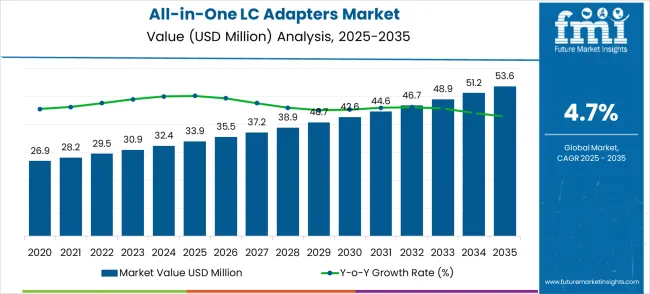
From 2029 to 2035, the curve transitions to a more stable slope, reflecting sustained expansion as the market matures across developed regions. Growth is reinforced by the deployment of next-generation optical networks, the expansion of data traffic, and increasing investments in high-speed broadband infrastructure. While the pace of adoption stabilizes, innovation in modular designs, higher-density configurations, and standardized interfaces ensures continued relevance and incremental gains. By 2035, the market records an absolute increase of USD 19.7 million, demonstrating consistent long-term value creation.
| Metric | Value |
|---|---|
| Estimated Value in (2025E) | USD 33.9 million |
| Forecast Value in (2035F) | USD 53.6 million |
| Forecast CAGR (2025 to 2035) | 4.7% |
The all-in-one LC adapters market is divided into data center connectivity at 40%, telecommunication networks at 25%, enterprise networking at 15%, fiber optic test and measurement equipment at 12%, and industrial/specialty applications at 8%. Data centers lead adoption due to the demand for high-density, high-speed fiber connections. Telecommunication networks rely on these adapters for reliable, compact, and scalable optical interfaces. Enterprise networking incorporates them to streamline cabling and improve network performance. Fiber optic testing applications use adapters for precise measurements and equipment calibration. Industrial and specialty uses include robotics, automation, and harsh-environment communication systems where compact and durable adapters enhance reliability. Current trends in the all-in-one LC adapters market include miniaturization and integration of multiple functionalities to support high-density network environments. Manufacturers are innovating with low-loss, high-precision adapters for improved signal quality and reduced downtime. Expansion into data centers, cloud infrastructure, and 5G telecommunication networks is increasing adoption. Development of multi-fiber push-on (MPO) compatible and ruggedized designs is enabling use in enterprise and industrial settings. Strategic collaborations between fiber optic component suppliers and network infrastructure providers are enhancing product offerings.
Market expansion is being supported by the increasing global demand for high-density fiber optic connectivity and the corresponding need for space-efficient optical components that can maximize port density while maintaining reliable connection performance across various network applications. Modern data center operators and telecommunications providers are increasingly focused on implementing connectivity solutions that can optimize rack space utilization, simplify installation procedures, and provide consistent optical performance in high-density environments. All-in-one LC adapters' proven ability to deliver compact connectivity, enhanced space efficiency, and simplified installation makes them essential components for contemporary network infrastructure and high-density data center deployments.
The growing focus on network densification and operational efficiency is driving demand for all-in-one LC adapters that can support high-port-count installations, reduce installation time, and enable efficient cable management across diverse network environments. Network operators' preference for components that combine space optimization with installation convenience and reliable performance is creating opportunities for innovative adapter implementations. The rising influence of cloud computing and edge networking demands is also contributing to increased adoption of all-in-one LC adapters that can provide efficient connectivity solutions without compromising network performance or operational flexibility.
The all-in-one LC adapters market is expanding steadily, driven by the growing demand for efficient and compact fiber optic connectivity solutions. Single-mode adapters dominate the fiber type segment with a 60% share, while multimode adapters account for around 40%. On the application side, telecommunication networks lead with a 45% share, followed by data centers at approximately 25%. These segments represent the most promising areas for investment, reflecting widespread adoption across network infrastructures and data handling facilities. Increasing deployment of high-speed networks and the need for reliable fiber connectivity are key factors supporting the growth of these segments.
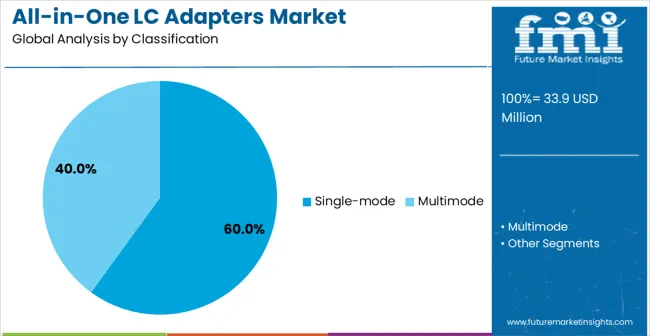
Single-mode LC adapters hold a 60% share of the fiber type market, reflecting their prevalence in long-distance and high-bandwidth applications. These adapters are favored for telecommunication networks, backbone infrastructures, and enterprise networking where signal integrity and low attenuation are critical. Key manufacturers include Senko Advanced Components, Amphenol, Corning, and TE Connectivity. Single-mode adapters provide stable performance in high-speed fiber optic systems, ensuring minimal signal loss over long distances. Their compatibility with dense wavelength division multiplexing (DWDM) and high-capacity networks reinforces their leading position, making them the preferred choice for telecom operators and large-scale networking deployments.
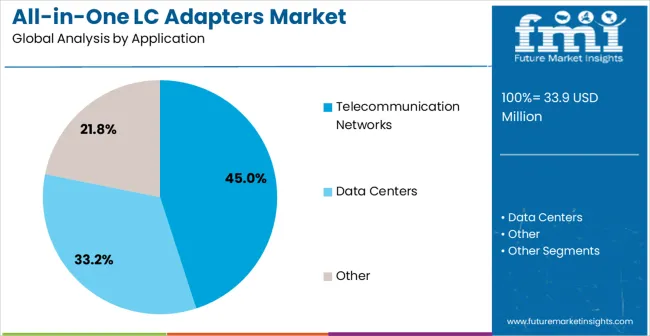
Telecommunication networks, accounting for a 45% share, remain the largest application for all-in-one LC adapters. These adapters are used extensively in backbone networks, central offices, and metropolitan area networks to connect fiber strands efficiently while maintaining high signal quality. Rising demand for high-speed broadband, 5G rollout, and network upgrades drives growth in this segment. Key players such as Senko Advanced Components, Amphenol, Corning, and TE Connectivity supply adapters that meet industry standards and ensure reliable performance. The segment’s expansion is fueled by global efforts to enhance telecommunication infrastructure and improve connectivity for enterprise and consumer networks.
The global all-in-one LC adapters market is growing steadily as demand for efficient fiber optic connectivity solutions rises. These adapters are widely used in data centers, telecommunication networks, and enterprise IT systems due to their compact design and reliable performance. They help maintain stable signal transmission while simplifying installation and cable management. Increasing deployment of high-speed networks and optical infrastructure supports market expansion. The high production costs and limited component availability create challenges for manufacturers and users. Technological improvements and expanding network infrastructure are expected to steady market growth in the coming years.
The need for efficient and high-performance connections in modern networks is driving adoption of all-in-one LC adapters. These components reduce installation complexity, minimize cable clutter, and ensure consistent optical transmission. Growth in data traffic, fueled by cloud services, video streaming, and 5G networks, is increasing demand for reliable optical connections. Manufacturers are offering solutions with low signal loss, high durability, and support for multiple fiber types. Adoption is particularly strong among network operators upgrading infrastructure to meet higher speed and capacity requirements. The preference for compact, versatile adapters is reinforcing their importance as essential components in modern fiber optic networks.
Market trends show increasing adoption of high-speed networks, pushing demand for compact and efficient all-in-one LC adapters. Network operators and enterprises prefer components that save space, reduce installation complexity, and maintain reliability. Multi-fiber compatibility and modular designs are becoming standard features. Manufacturers focus on enhancing performance, durability, and ease of deployment. Innovations in design and functionality are shaping market direction, ensuring all-in-one LC adapters remain central to high-performance network installations while supporting the expansion of next-generation optical systems.
The all-in-one LC adapter market faces challenges due to high production costs and limited component availability. Precision manufacturing, quality standards, and material requirements increase expenses for producers. Supply chain disruptions, including delays in the production of optical fiber and connector materials, can affect timely delivery. Compatibility requirements across various fiber types and high-density systems add complexity. Smaller network operators may struggle to invest in upgrades, which can limit adoption in certain regions. Ensuring consistent quality while meeting global demand remains a challenge. Manufacturers are focusing on improving production efficiency, diversifying sourcing, and optimizing distribution to overcome these obstacles and support steady market growth.
The global All-in-One LC adapters market is set to grow at a CAGR of 4.7% between 2025 and 2035, with notable regional variations. China leads at 6.3%, supported by rapid expansion of fiber optic infrastructure and high-speed network deployment. India follows at 5.9%, driven by government digital initiatives and rising data traffic, both part of the BRICS group alongside Brazil, which grows at 4.9% due to broadband modernization projects. Germany records 5.4%, reflecting steady industrial and telecom investments in Europe. The USA grows at 4.5%, while the UK reaches 4%, reflecting mature markets with gradual upgrades. Japan shows slower expansion at 3.5% owing to well-established networks. ASEAN and Oceania countries are adopting these solutions at 4-5%, driven by increasing internet penetration and urban connectivity projects.
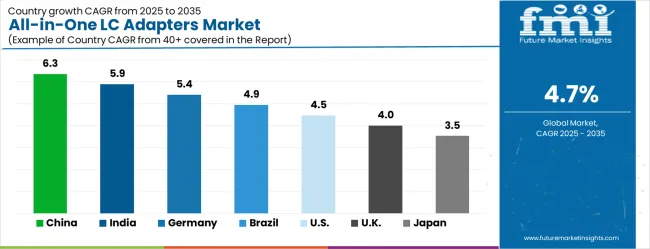
| Country | CAGR (2025-2035) |
|---|---|
| China | 6.3% |
| India | 5.9% |
| Germany | 5.4% |
| Brazil | 4.9% |
| USA | 4.5% |
| UK | 4.0% |
| Japan | 3.5% |
China accounts for a leading share of the global All-in-One LC Adapters market with projected CAGR of 6.3% between 2025 and 2035, higher than the global average of 4.7%. Growth is driven by increasing deployment in telecommunications, data centers, and enterprise networking infrastructure. Large-scale adoption of fiber optic networks in eastern and northern provinces supports expansion. Major suppliers, including Corning and TE Connectivity, are collaborating with domestic distributors to optimize delivery and integration into large projects. Rising demand for compact, high-efficiency adapters in high-density fiber setups is shaping procurement trends. Automation in testing and installation is being implemented to reduce operational costs and improve network reliability. Expansion is further supported by government-backed fiber optic initiatives and increasing cloud infrastructure development.
India is expected to experience 5.9% CAGR in the All-in-One LC Adapters market from 2025 to 2035, contributing significantly to the global market. Growth is fueled by the expansion of telecom networks, 5G infrastructure, and increasing data center deployments in metropolitan regions such as Mumbai, Bangalore, and Delhi. Local and multinational suppliers, including Panduit and Amphenol, are providing solutions to improve installation speed and compatibility. Rising use of high-performance adapters in enterprise networks and optical LAN projects is shaping market demand. The adoption of compact, multifunctional devices allows for reduced installation space and enhanced network efficiency. Government-backed digital initiatives supporting broadband and smart city programs further reinforce market growth.
Germany is projected to grow at 5.4% CAGR in the All-in-One LC Adapters market through 2035. Industrial adoption is concentrated in automotive, telecommunications, and manufacturing sectors requiring high-speed fiber networks. Suppliers such as Corning and TE Connectivity offer solutions tailored for high-density and enterprise networking environments. Regional adoption is strongest in Bavaria and North Rhine-Westphalia due to dense industrial clusters and advanced IT infrastructure. Network optimization projects are driving demand for multifunctional adapters with enhanced connectivity and minimal signal loss. Government incentives for digital infrastructure upgrades and high-speed connectivity expansion are contributing to growth. Data-driven deployment strategies ensure improved operational efficiency in enterprise and industrial networks.
Brazil is expected to expand at 4.9% CAGR in the All-in-One LC Adapters market, slightly above the global average. Adoption is focused on telecommunication networks, broadband expansion projects, and urban enterprise data centers. Suppliers including Amphenol and Corning are providing cost-effective solutions adapted for Latin American network infrastructure. Fiber-to-the-home (FTTH) initiatives are accelerating demand in major cities such as São Paulo, Rio de Janeiro, and Brasília. Compact adapters with multifunctional capabilities are preferred for reducing installation complexity in dense network environments. Growth is supported by government programs targeting connectivity expansion and private sector investments in cloud infrastructure.
The United States is projected to grow at 4.5% CAGR between 2025 and 2035. High adoption is driven by cloud data centers, enterprise networking, and telecom infrastructure upgrades. Suppliers such as Corning, Panduit, and TE Connectivity are offering high-performance adapters optimized for dense fiber networks. Adoption is concentrated in California, Texas, and New York, where enterprise and hyperscale data centers dominate. Increased demand for modular and multifunctional adapters ensures reduced space requirements and operational efficiency. Network expansion, including 5G deployments and high-speed optical infrastructure projects, reinforces growth. Data-driven network planning is enhancing adoption rates and reducing deployment delays.
The United Kingdom is expected to achieve 4.0% CAGR in All-in-One LC Adapters adoption through 2035. Expansion is concentrated in telecom, enterprise, and government networking infrastructure. Suppliers, including Amphenol and TE Connectivity, provide compact and multifunctional adapters suitable for urban and campus networks. London, Manchester, and Birmingham are key regions driving adoption due to data center concentration and digital infrastructure upgrades. Compact adapters are increasingly preferred to reduce cabling complexity and improve network reliability. Adoption is reinforced by government broadband initiatives and enterprise IT modernization programs. Data-driven deployment strategies ensure optimal utilization and maintenance efficiency.
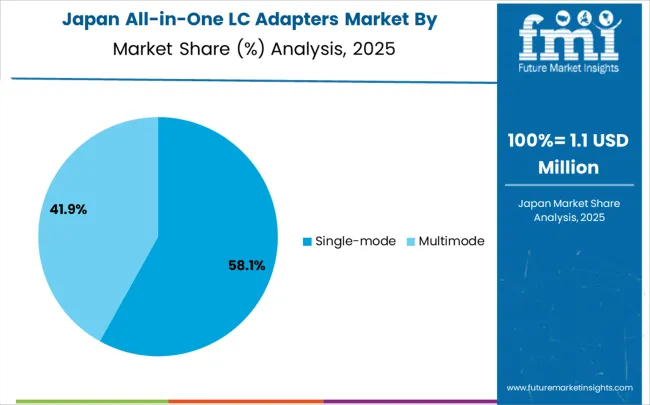
Japan is projected to grow at 3.5% CAGR, below the global average of 4.7%, reflecting a mature market. Adoption is focused on high-density fiber networks, smart cities, and enterprise networking solutions. Suppliers such as Corning and Panduit provide multifunctional adapters with high reliability and low signal loss. Tokyo, Osaka, and Nagoya are key adoption hubs due to concentration of commercial data centers and advanced IT infrastructure. Increased integration in automated testing and predictive maintenance programs improves operational efficiency. Market growth is steady, driven by the replacement of legacy fiber infrastructure and demand for compact, high-performance adapters.
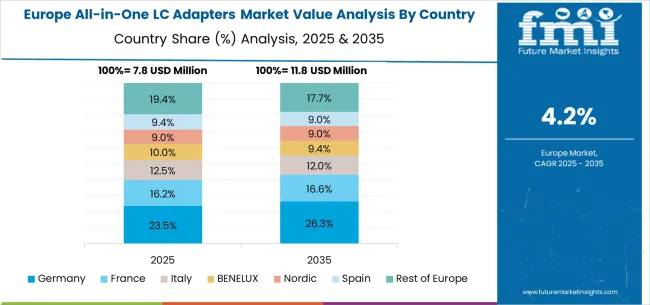
The all-in-one LC adapters market in Europe is projected to grow from USD 7.9 million in 2025 to USD 12.5 million by 2035, registering a CAGR of 4.7% over the forecast period. Germany is expected to maintain its leadership position with a 30.8% market share in 2025, moderating slightly to 30.5% by 2035, supported by its strong telecommunications infrastructure, advanced optical networking capabilities, and comprehensive manufacturing networks serving major European markets.
The United Kingdom follows with a 22.5% share in 2025, projected to reach 22.7% by 2035, driven by robust fiber optic network deployment, established telecommunications infrastructure, and strong demand for reliable optical connectivity solutions across carrier and enterprise applications. France holds an 18.4% share in 2025, rising to 18.6% by 2035, supported by telecommunications modernization programs and increasing adoption of high-performance optical networking technologies in service provider networks. Italy records 12.7% in 2025, inching to 12.8% by 2035, with growth underpinned by telecommunications infrastructure improvement and increasing data center development activities. Spain contributes 9.1% in 2025, moving to 9.2% by 2035, supported by expanding fiber optic networks and telecommunications service enhancement programs. The Netherlands maintains a 3.2% share in 2025, growing to 3.3% by 2035. The Rest of Europe region, including Nordic countries, Eastern Europe, Belgium, Switzerland, and Austria, is anticipated to gain momentum, expanding its collective share from 3.3% to 2.9% by 2035, attributed to increasing adoption of advanced optical networking solutions in Nordic countries and growing telecommunications activities across Eastern European markets implementing infrastructure modernization programs.
The all-in-one LC adapters market is characterized by competition among established optical component manufacturers, specialized fiber optic connectivity providers, and integrated telecommunications solution companies. Companies are investing in advanced optical technology research, connector design enhancement, precision manufacturing improvements, and comprehensive product portfolios to deliver consistent, high-performance, and reliable optical connectivity solutions. Innovation in optical connector design, automated manufacturing processes, and high-density packaging technologies is central to strengthening market position and competitive advantage.
SENKO Advanced Components leads the market with a strong market share, offering comprehensive optical connectivity solutions with a focus on high-density applications and space optimization capabilities. Amphenol provides specialized fiber optic components with an attention on telecommunications and data center markets. WCFO delivers innovative connectivity solutions with a focus on advanced optical networking and industrial applications. SANWA specializes in precision optical components with focus on telecommunications infrastructure and network equipment integration. HYC focuses on optical networking components and comprehensive connectivity solutions for diverse market applications. Yingfeng Optical Communication offsusers specialized optical connectivity systems with focus on telecommunications and data center environments.
All-in-one LC adapters represent a specialized high-density connectivity segment within fiber optic telecommunications infrastructure, projected to grow from USD 33.9 million in 2025 to USD 53.6 million by 2035 at a 4.7% CAGR. These compact optical interconnect solutions—primarily single-mode configurations for long-distance transmission—enable space-efficient connections in data centers (USD 12.1 million in 2025) and telecommunication networks requiring maximum port density and simplified installation procedures. Market expansion is driven by increasing data center densification demands, growing 5G network deployment, rising need for rack space optimization, and expanding cloud computing infrastructure requiring high-density fiber optic connectivity solutions.
How Telecommunications Standards Organizations Could Advance Connectivity Standards and Interoperability?
How Data Center Operators Could Optimize Infrastructure Density and Efficiency?
How Component Manufacturers Could Drive Innovation and Market Leadership?
How Could Network Equipment Manufacturers Enhance System Integration?
How Telecommunications Service Providers Could Optimize Network Infrastructure?
How Investors and Financial Enablers Could Support Market Development and Innovation?
| Items | Values |
|---|---|
| Quantitative Units (2025) | USD 33.9 million |
| Fiber Type | Single-mode, Multimode |
| Application | Data Centers, Telecommunication Networks |
| Regions Covered | North America, Europe, East Asia, South Asia & Pacific, Latin America, Middle East & Africa |
| Countries Covered | United States, Canada, United Kingdom, Germany, France, China, Japan, South Korea, India, Brazil, Australia and 40+ countries |
| Key Companies Profiled | SENKO Advanced Components, Amphenol, WCFO, SANWA, HYC, and Yingfeng Optical Communication |
| Additional Attributes | Dollar sales by fiber type and application category, regional demand trends, competitive landscape, technological advancements in optical connectivity, high-density packaging innovation, manufacturing automation development, and performance optimization |
The global all-in-one LC adapters market is estimated to be valued at USD 33.9 million in 2025.
The market size for the all-in-one LC adapters market is projected to reach USD 53.6 million by 2035.
The all-in-one LC adapters market is expected to grow at a 4.7% CAGR between 2025 and 2035.
The key product types in all-in-one LC adapters market are single-mode and multimode.
In terms of application, telecommunication networks segment to command 45.0% share in the all-in-one LC adapters market in 2025.






Our Research Products

The "Full Research Suite" delivers actionable market intel, deep dives on markets or technologies, so clients act faster, cut risk, and unlock growth.

The Leaderboard benchmarks and ranks top vendors, classifying them as Established Leaders, Leading Challengers, or Disruptors & Challengers.

Locates where complements amplify value and substitutes erode it, forecasting net impact by horizon

We deliver granular, decision-grade intel: market sizing, 5-year forecasts, pricing, adoption, usage, revenue, and operational KPIs—plus competitor tracking, regulation, and value chains—across 60 countries broadly.

Spot the shifts before they hit your P&L. We track inflection points, adoption curves, pricing moves, and ecosystem plays to show where demand is heading, why it is changing, and what to do next across high-growth markets and disruptive tech

Real-time reads of user behavior. We track shifting priorities, perceptions of today’s and next-gen services, and provider experience, then pace how fast tech moves from trial to adoption, blending buyer, consumer, and channel inputs with social signals (#WhySwitch, #UX).

Partner with our analyst team to build a custom report designed around your business priorities. From analysing market trends to assessing competitors or crafting bespoke datasets, we tailor insights to your needs.
Supplier Intelligence
Discovery & Profiling
Capacity & Footprint
Performance & Risk
Compliance & Governance
Commercial Readiness
Who Supplies Whom
Scorecards & Shortlists
Playbooks & Docs
Category Intelligence
Definition & Scope
Demand & Use Cases
Cost Drivers
Market Structure
Supply Chain Map
Trade & Policy
Operating Norms
Deliverables
Buyer Intelligence
Account Basics
Spend & Scope
Procurement Model
Vendor Requirements
Terms & Policies
Entry Strategy
Pain Points & Triggers
Outputs
Pricing Analysis
Benchmarks
Trends
Should-Cost
Indexation
Landed Cost
Commercial Terms
Deliverables
Brand Analysis
Positioning & Value Prop
Share & Presence
Customer Evidence
Go-to-Market
Digital & Reputation
Compliance & Trust
KPIs & Gaps
Outputs
Full Research Suite comprises of:
Market outlook & trends analysis
Interviews & case studies
Strategic recommendations
Vendor profiles & capabilities analysis
5-year forecasts
8 regions and 60+ country-level data splits
Market segment data splits
12 months of continuous data updates
DELIVERED AS:
PDF EXCEL ONLINE
LC Standard Adapters Market Size and Share Forecast Outlook 2025 to 2035
LC Fiber Optic Adapters Market Size and Share Forecast Outlook 2025 to 2035
LC Dust Shutter Adapters Market Size and Share Forecast Outlook 2025 to 2035
LCD Digital Microscope Market Size and Share Forecast Outlook 2025 to 2035
LCD Glass Market Size and Share Forecast Outlook 2025 to 2035
LCD TV Core Chip Market Size and Share Forecast Outlook 2025 to 2035
LCR Meters Market Analysis - Size, Share, and Forecast Outlook 2025 to 2035
Alcohol Packaging Market Forecast and Outlook 2025 to 2035
Alcoholic Drinks Packaging Market Size and Share Forecast Outlook 2025 to 2035
Alcohol Dehydrogenase Enzymes Market Size and Share Forecast Outlook 2025 to 2035
Alcohol Based Disinfectants Market Size and Share Forecast Outlook 2025 to 2035
Ulcerative Colitis Treatment Market Size and Share Forecast Outlook 2025 to 2035
Alcohol Ingredients Market Analysis - Size, Share, and Forecast Outlook 2025 to 2035
Alcoholic Flavors Market Size, Growth, and Forecast for 2025 to 2035
Ulcerated Necrobiosis Lipoidica Management Market Trends - Growth & Forecast 2025 to 2035
Alcoholic Hepatitis Treatment Market Analysis - Size, Share & Forecast 2025 to 2035
Alcohol Use Disorder Treatment Market Growth - Demand & Innovations 2025 to 2035
Assessing Alcohol Packaging Market Share & Industry Trends
Alcohol Ethoxylates Market Demand & Growth 2025-2035
PLC Controlled Packing Machine Market Trends – Forecast 2024-2034

Thank you!
You will receive an email from our Business Development Manager. Please be sure to check your SPAM/JUNK folder too.
Chat With
MaRIA